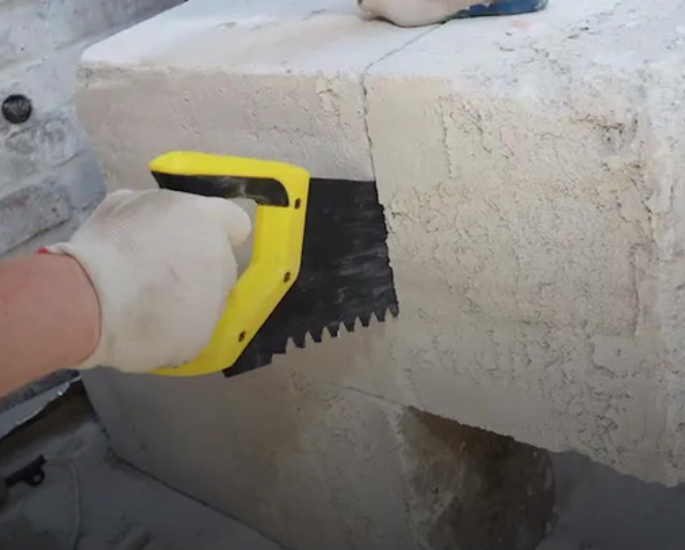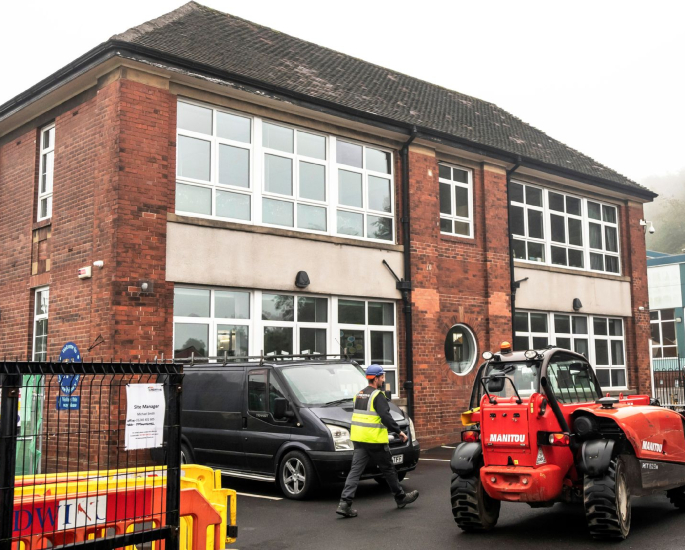Concrete School Closures List & the Impact on Learning
There’s been growing demand for the Department for Education (DfE) to unveil the comprehensive list of school closures due to inadequate concrete.
This recent development means that students all across the nation will have to return to their studies, either online or in temporary facilities, due to the government’s immediate closure orders for over 100 schools.
These orders stem from concerns regarding a type of concrete described as “80% air”.
This unique material, known as reinforced autoclaved aerated concrete (RAAC), was historically used in UK construction.
However, it has since been discovered to carry the risk of structural collapse.
The government has identified a total of 156 schools containing RAAC, with 104 requiring immediate action and 52 already undergoing repair work.
In Scotland, Sky News reports that 35 schools have been affected, though no closure announcements have been made thus far.
In response to the mounting concerns, Education Secretary Gillian Keegan has pledged that the government will soon disclose the names of the impacted schools.
Meanwhile, teaching unions have decried the turmoil surrounding the return to school, branding it “nothing short of a scandal.”
However, what does this mean for UK pupils and the future of schooling?
What is RAAC concrete?


Firstly, what exactly is RAAC concrete?
The substance is a fascinating lightweight concrete variant, that found its way into the construction of schools, colleges, and various other buildings from the 50s until the mid-90s.
This innovative material comes into existence through a blend of cement, lime, water, and an aeration agent.
What truly sets it apart is the remarkable process it undergoes.
The mixture is carefully poured into molds and then subjected to high pressure and heat, a method known as autoclaving.
This unique process transforms it into a material that’s not only lightweight but also incredibly strong and porous, making it a key player in the world of construction materials.
Whilst it may sound like a solid and sturdy material, the recent impact on school buildings has emphasised that this isn’t the case.
What Schools are Impacted?


Here is an ongoing compilation of schools in England that have found themselves on the “crumbling building” list, potentially affected by the recent order from the DfE:
- Ferryhill School, County Durham: This secondary school is experiencing a delayed start to the 2023 academic year. Students are expected to commence classes a week later, with online learning as an interim solution.
- Willowbrook Mead Primary Academy, Leicester: Parents have been instructed to send their children to two different schools, and older pupils are transitioning to home-schooling.
- Corpus Christi Catholic Primary School, Brixton, South London: The school has announced that junior students will be relocated to a nearby area.
- Crossflats Primary School, Bradford: The school has been partially closed, as confirmed by Bradford Council.
- Eldwick Primary School, Bradford: This school is also partially closed, according to Bradford Council.
- Mayflower Primary School, Leicester: Efforts are underway to arrange alternative accommodation to ensure in-person teaching can swiftly resume.
- Parks Primary School: Alternative accommodation is being organised for the affected students.
- Corpus Christi Catholic School, Brixton Hill, Lambeth: This school had to close before the start of the new term due to RAAC concerns in the roof, necessitating a temporary relocation of junior pupils.
- Springfield Primary School, Chelmsford: The school has reported the completion of roof works in four junior classrooms, with Essex County Council providing temporary classrooms on the junior playground until the rest are finished.
- Ravens Academy, Essex: The school will be closed for two days on September 5 and 6.
- St Clere’s School, Essex: Parts of the school will be closed, and remote learning will be partially implemented due to insufficient teaching spaces.
- Abbey Lane Primary School, Sheffield: Roof work to replace RAAC over the kitchen was initiated in July, with alternative meal arrangements for pupils during the renovation.
- The Billericay School, Essex: A “small section” of the school’s estate contains RAAC, but a full closure is not deemed necessary.
- Canon Slade School, Bolton: Some areas have been closed for safety reasons, as reported by local press.
- Clacton County High School, Essex: The start of the term has been delayed, and remote learning is being utilised in certain areas.
- Carmel College and Sixth Form, Darlington: The kitchen and library have been closed, but the school remains open.
- Cockermouth School, Cumbria: Pupils will return to school a day later due to RAAC being found in four corridors.
- Cranbourne College, Basingstoke: One area has been closed since the beginning of 2023, with temporary measures in place elsewhere in the school. However, the school remains open.
- Donnington Wood Infants School, Shropshire: The school will remain open after additional ceilings were added.
- East Bergholt High School, Colchester: The school is considering whether to delay reopening or partially close.
- The Gilberd School, Colchester: It will remain closed until September 11 for certain year groups, with year seven pupils returning on September 12.
- Hadleigh High School, Suffolk: A delay to the start of the new term is under consideration.
- Hatfield Peverel Junior School, Essex: Closure is expected until mid-September at the earliest, with temporary classrooms needed.
- Hockley Primary School, Essex: The school has been closed since June 11, with some year groups relocated to other schools.
- Holy Trinity Catholic Academy, Nottinghamshire: Issues have been identified, but the school will remain open.
- Honywood School, Colchester: 22 classrooms will be closed immediately, with online learning required for some students.
- Jerounds Primary School, Essex: RAAC was found in the school’s kitchen, leading to structural support by a steel structure, but the school remains open.
- Katherines Primary Academy, Essex: The main building has been closed.
- Kingsdown School, Essex: The main building of this special school for children aged three to 14 years old has been closed.
- Our Lady’s Catholic High School, Lancashire: The school is closed on September 4 and 5.
- Outwoods Primary School, North Warwickshire: Precautionary measures were taken earlier in 2023 to install extra support, but the school remains open.
- Ramsey Academy, Essex: Four classrooms have been cleared out and are out of use until safety measures are implemented.
- St Gregory’s Catholic Science College, London: Efforts are underway to reinforce the concrete with supports, and the school remains open.
- St Leonard’s School, County Durham: The school will be closed.
- St Teresa’s Catholic Primary School, County Durham: Closure is expected until September 11.
- St Thomas More Catholic Comprehensive, London: The school is open, but certain areas, including the hall, gym, canteen, drama studio, and toilets, are closed, and mobile toilet blocks will be needed.
- White Hall Academy Primary, Essex: Three non-teaching days have been announced.
- Winter Gardens Academy, Essex: Parts of the school will be vacated immediately.
- Wood Green Academy, West Midlands: Some classrooms will remain closed until October.
- Woodville Primary School, Essex: Closure is expected until September 11.
- Wyburns Primary School, Essex: Closure is anticipated for up to two weeks.
The situation continues to develop, and affected schools are taking various measures to address the challenges posed by RAAC concerns.
Various councils and officials across the UK have provided updates on the situation regarding RAAC in schools:
Leeds City Council (Jonathan Pryor, Deputy Leader): Leeds has not yet identified any RAAC in its schools.
Dudley Council: Dudley Council reassured parents via social media (Twitter) that all borough schools are expected to reopen as scheduled. They have not identified any schools affected by RAAC.
Essex Council: Essex Council has stated that disruption to local authority schools is minimal and expects only one local authority school to be affected.
Alarmingly, the council does not plan to disclose the names of impacted schools at this time.
However, parents and caregivers of affected schools will be contacted directly by the schools themselves.
Around 50 schools in Essex have known RAAC, but most will be able to open as usual when the term begins, thanks to existing systems.
Schools Minister Nick Gibb assured parents that it is safe to send their children to school if no information has been communicated from their schools.
He emphasised the government’s commitment to cover all capital costs for schools needing full or partial relocation due to RAAC concerns.
This includes the possibility of using portacabins for alternative accommodation, with the government pledging to cover all associated expenses.
How Will Students Learn?


Whilst parents are still trying to gather as much information as possible about their children’s schools, the question remains on where or how they will learn.
With some schools open, partly open, or relocating to other areas, there could be certain methods implemented across the UK.
Here are the various ways students will learn in response to the RAAC concerns affecting different schools:
Online Learning
Students at some schools will engage in online learning as a temporary measure to ensure education continuity.
This includes schools like Ferryhill School in County Durham.
Home-Schooling
Older students from certain schools, such as Willowbrook Mead Primary Academy in Leicester, are transitioning to home-schooling during the RAAC-related disruptions.
Relocation to Nearby Areas
In instances where school facilities are impacted, such as Corpus Christi Catholic Primary School in Brixton, junior students may be relocated to nearby areas to continue their education.
Partial Closures with Remote Learning
Some schools, like Crossflats Primary School in Bradford and St Clere’s School in Essex, are partially closed, and remote learning is partially implemented to accommodate students.
Temporary Closures with Remote Learning
A few schools, such as The Gilberd School in Colchester, St Leonard’s School in County Durham, and others, have temporarily closed, and remote learning is expected to be used during this period.
This means more sessions on Zoom and Google Meets will be used, similar to the school terms during COVID-19.
Open with Modifications
Some schools have remained open but with modifications.
These modifications may include partial closures of specific areas, the use of temporary classrooms, or the need for structural support.
Therefore, students may need to use rooms that aren’t classrooms such as gyms, cafeterias, or offices that have safer constructions.
These various approaches are designed to ensure that students continue to receive education despite the challenges posed by RAAC concerns.
Schools are adapting their teaching methods to prioritise student safety while minimizing disruptions to learning.
How to Know if your Child’s School is Closing


Schools will be in direct contact with parents/guardians/caregivers if there is any delay or change to the start of the term.
Nick Gibb outlined:
“The vast majority have [contacted parents].
“We have been calling them yesterday, but there are a few more that we’re calling today, and those schools are now talking to parents about what’s going to happen in their school.”
However, if a child’s school is forced to close down, pupils could be moved to an emergency or longer-term accommodation on a different site.
If the school your child is attending is forced to close down, pupils may be moved to emergency or longer-term temporary accommodation on a different school site.
But, it is the school’s duty to provide this information as early as possible to those it will affect.